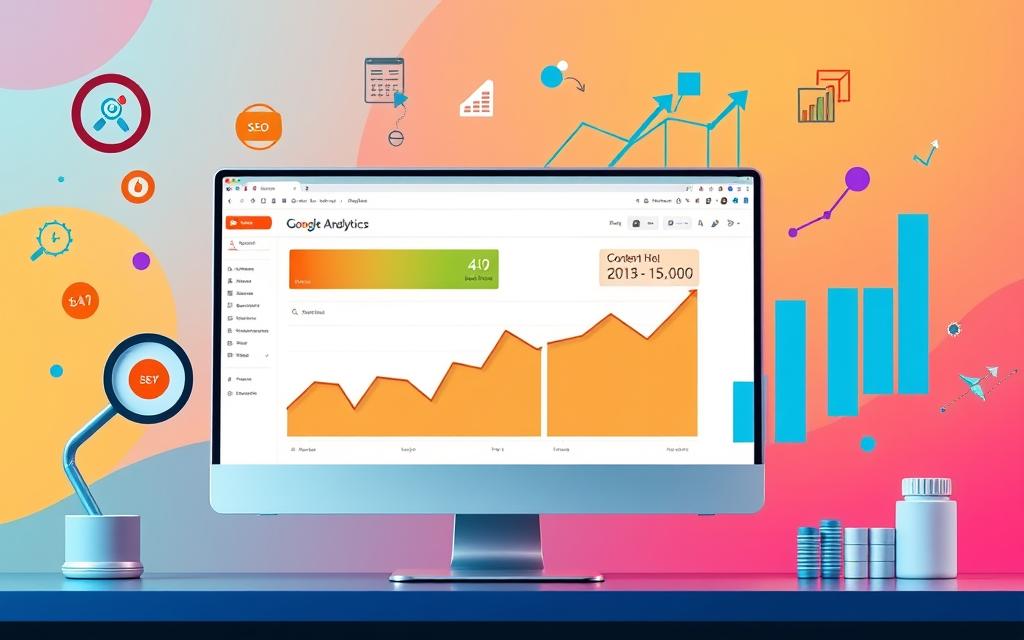Boost Your Strategy with Content Performance Metrics
Did you know over 68% of online experiences start with a search engine? This shows how important it is for brands to use content performance metrics. They help increase visibility and drive more organic traffic. With 56% of buyers using long-tail search queries, knowing SEO metrics is key to reaching them.
More than 53% of marketers aim to improve content quality in 2023. Content performance metrics are not just for tracking. They guide the whole content strategy. By measuring key performance indicators, brands can find what works and what doesn’t. This leads to more engagement and higher conversions.
With insights from content analysis, marketers can make their content more effective. They ensure every piece connects with their audience.
Key Takeaways
- SEO metrics are essential for measuring content performance and driving organic traffic.
- Understanding and analyzing traffic metrics help gauge content reach and effectiveness.
- Engagement metrics provide insights into audience involvement and content popularity.
- High-quality content is increasingly prioritized by marketers in the digital space.
- Tracking conversions is critical for evaluating the effectiveness of content in achieving business goals.
- Utilizing tools for content analysis simplifies performance tracking and data-driven decisions.
Understanding the Importance of Content Performance Metrics
In today’s digital world, knowing how your content performs is key. Only 11% of companies say they’re great at content marketing. Yet, 84% know they need a strong content strategy to get noticed.
By looking at these metrics, brands can make content that people want to see. This helps attract new leads and grow their audience.
Enhancing Visibility in a Competitive Landscape
In a world full of competition, making your content stand out is crucial. Keeping an eye on traffic, pageviews, and how users interact with your content is important. It shows what works best with your audience.
Brands need to figure out where their organic traffic comes from. This helps them improve how they share their content. It’s all about catching people’s attention with the right strategy.
Driving Effective Lead Generation with Engaging Content
Good content is essential for getting new leads. It’s important to track things like subscriptions and clicks. This shows how well your content is working to bring in new customers.
By understanding how your content performs, you can make it better. This helps you connect with your audience on a deeper level. It’s all about finding the content that really speaks to your target audience.
Key Metrics to Track for Performance Analysis
It’s key to understand and keep an eye on important metrics for any content plan. These metrics show how well your content and marketing do. By looking at traffic, engagement, and conversion metrics, businesses can make smart choices to boost their online presence.
Traffic Metrics: Assessing Your Content Reach
Traffic metrics are crucial for seeing how your content does online. Numbers like pageviews and unique visitors show how far your content goes. For instance, “How to do an end-of-year expense report” got 5,987 pageviews, showing it’s a hit.
By watching these numbers, businesses can see what content works best. This helps them plan better content for their audience. Good website analytics can show what users like, helping to create content that meets their needs.
Engagement Metrics: Measuring Audience Involvement
Engagement metrics tell us how users interact with your content. Looking at time on page and bounce rates shows how engaged users are. For example, a post with 11,562 pageviews but only a 1-minute average time on page might not hold users’ attention.
But, “How to do an end-of-year expense report” kept users for 6 minutes. This shows it’s more engaging. Comparing these numbers helps see what content keeps users interested, improving overall engagement.
Conversion Metrics: Understanding Goal Conversions
Conversion metrics show what actions users take on your site. They tell you if your CTAs and content strategy work. The conversion rate shows how many visitors do what you want them to, showing your content’s success.
Tracking these metrics regularly helps businesses improve their strategies. It ensures their content meets user needs and business goals.
Content Performance Metrics: What You Need to Monitor
To succeed with your content, it’s key to watch certain performance metrics. These metrics show how your content connects with your audience. They also point out where you can get better. By looking at pageviews, average time on page, and bounce rate, you learn a lot about your content’s success and how engaged your audience is.
Pageviews: Gauging Content Popularity
Pageviews are a basic way to see how popular your content is. They show how often people visit your pages. Tools like Google Analytics give you detailed info on who’s visiting and where they’re from. This helps you understand your audience and plan your content better.
Average Time on Page: Evaluating Engagement
Average time on page tells you how interesting your content is. If people stay longer, it’s good. But if they leave quickly, it might not be engaging enough. By watching how visitors scroll, you can see what keeps them interested. This helps you make your content more engaging.
Bounce Rate: Identifying Content Issues
Bounce rate shows how many visitors leave after seeing just one page. A high bounce rate means your content might not meet their needs. Knowing this helps you find and fix problems. It also helps keep more visitors on your site.
Tools for Tracking Content Performance
Today, marketers need to use effective tools for content analysis. This helps them get valuable insights into how well their content is doing. Google Analytics is a top choice, offering a free plan for small businesses. It lets them understand how users interact with their content.
It shows data on where traffic comes from and how engaged users are. This is key for seeing if a content strategy is working.
Utilizing Google Analytics for In-Depth Insights
Google Analytics lets businesses see how users behave. It shows which content they like best. The paid plan, Analytics 360, is for bigger companies needing more advanced analytics.
Prices for this plan are available upon request. With it, marketers can track things like bounce rate and time on page. This gives a clear view of how well content is doing.
Exploring SEO Tools for Performance Tracking
SEO tools are crucial for tracking performance. They give insights into keyword rankings and trends in organic traffic. SEMrush and Moz are great for this, with plans starting at $99 a month.
These tools help spot what’s working and what’s not. To learn more about content marketing analytics tools, visit this page.

Strategies for Improving Engagement Rates
To boost engagement rates, focus on creating and presenting content well. Use catchy headlines and clear meta descriptions to grab attention. This approach makes your content more appealing and interactive.
Crafting Compelling Headlines and Meta Descriptions
Headlines should be interesting and match your audience’s interests. A good meta description should give a quick summary of your content. This encourages people to click and engage with your material.
Using the right keywords in these areas can also help. It makes your content more visible online, leading to more engagement.
Incorporating Visuals to Retain Audience Attention
Visuals like images, infographics, and videos are key to keeping people interested. They make your content more engaging and easier to understand. These elements also help keep information in the audience’s mind.
Studies show that using different types of visuals can increase engagement. This makes your content more effective overall.
Data-Driven Decisions: The Path to Content Optimization
In today’s digital world, making decisions based on data is key for great content. By studying how users act, businesses can learn a lot. This helps them create content that people want to see and interact with.
Analyzing User Behavior to Inform Content Strategy
Using tools like Google Analytics 4 and LinkedIn Analytics helps businesses see what content works. For example, the University of Rochester saw a huge jump in website visitors by using data well. This shows how important it is to use data to make smart marketing choices.
Prioritizing Changes Based on Metrics
Companies need to make changes based on solid data. It’s hard to know which data is most important. But by always checking how things are going, they can get better and better.

By focusing on what data says, marketers can make content that really connects with people. This way, businesses can reach more people and make them happier.
For more tips on making content that grabs attention, check out strategic content creation strategies that meet today’s needs.
Challenges in Measuring Content Performance
Measuring content performance is tough. It’s hard to stand out in a sea of digital content. Finding unique ways to grab attention is key. Without it, your content might not reach your audience.
Navigating Content Saturation
Too much content makes it hard to measure success. Marketers need to be creative to stand out. Creating unique content helps cut through the noise.
While it’s tough, it also pushes for more creativity and relevance. This is crucial for connecting with your audience.
Adapting to Changing Search Engine Algorithms
Search engine algorithms change often. Keeping up with these changes is crucial. It helps your content reach more people.
Organizations must update their strategies to meet these changes. This requires a lot of effort. But, being proactive helps achieve better content performance.
Testing and Optimization for Continuous Improvement
In digital marketing, testing and optimization are key for better content performance. A/B testing lets marketers try different content parts, like headlines and images. This helps find out what works best with their audience.
It gives insights into how users interact with content. This information helps make better choices that boost sales. Also, tracking user engagement and sales helps improve overall performance.
Implementing A/B Testing for Rates Improvement
A/B testing helps marketers improve their strategies by testing different approaches. For example, a retail company might test different email subject lines. If they see more people opening and clicking on emails, they can make more sales.
By watching important metrics like how much it costs to get a new customer, businesses can keep getting better. This ensures their marketing meets what their audience wants.
Carrying Out Content Audits to Refresh Older Posts
Regular content audits are also crucial. They help keep content fresh and relevant. By updating old posts and making them match current trends, marketers improve user experience.
This ongoing effort keeps content valuable. It helps grow the audience and meet marketing goals. It’s a cycle of making content better and better over time.
FAQ
What are Content Performance Metrics?
Content Performance Metrics measure how well content works. They help brands see if their content meets goals, gets noticed, and grows.
How can Content Performance Metrics drive engagement rates?
By using Content Performance Metrics, companies can find out what works and what doesn’t. This helps them make better content that people want to see and interact with.
Why are SEO metrics important in content analysis?
SEO metrics are key because they show how well content ranks on search engines. This affects how much organic traffic a site gets.
What key metrics should I monitor for performance analysis?
You should watch traffic, like pageviews, and how long people stay on your site. Also, look at how well your calls to action (CTAs) work.
How does Google Analytics assist with content performance tracking?
Google Analytics gives deep insights into how users interact with your site. It shows where visitors come from, how they engage, and what they do. This helps marketers improve their content plans.
What strategies can improve engagement rates on my website?
To get more engagement, make your headlines and descriptions catchy. Use images and videos to grab and keep people’s attention.
Why is analyzing user behavior essential for content optimization?
Knowing how users behave helps you create content they like. It lets you adjust your strategy to match what your audience wants.
What challenges might I face when measuring content performance?
You might struggle with too much content out there. Also, search engine changes can affect your rankings and visibility.
How can A/B testing contribute to content performance improvement?
A/B testing lets you try different content parts to see what works best. This helps you find what your audience likes most and boosts conversions.
What is the value of conducting regular content audits?
Regular audits keep your content fresh and relevant. They update old content to match current trends, improving user interest and engagement.







